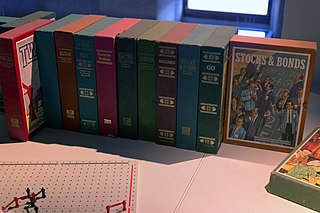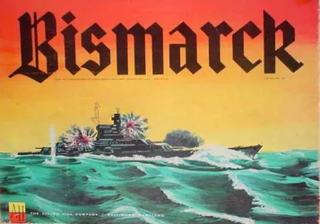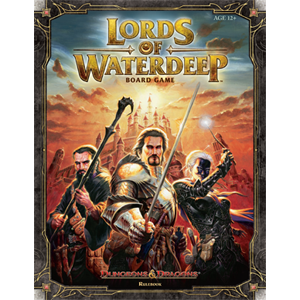Related Research Articles

HeroQuest, is an adventure board game created by Milton Bradley in conjunction with the British company Games Workshop in 1989, and re-released in 2021. The game is loosely based around archetypes of fantasy role-playing games: the game itself was actually a game system, allowing the gamemaster to create dungeons of their own design using the provided game board, tiles, furnishings and figures. The game manual describes Morcar/Zargon as a former apprentice of Mentor, and the parchment text is read aloud from Mentor's perspective. Several expansions have been released, each adding new tiles, traps, artifacts, and monsters to the core system.

War at Sea is a strategic board wargame depicting the naval war in the Atlantic during World War II, published by Jedko Games in 1975, and subsequently republished by Avalon Hill in 1976 and more recently by L2 Design Group in 2007.

Kingmaker is a board game published in the UK by PhilMar Ltd. in 1974 that simulates the political struggles to place a king on the throne of England during the Wars of the Roses. The game was popular, and other editions, including a computerized version, were produced by Avalon Hill, TM Games, and Gibsons Games. The game won a Charles S. Roberts Award in 1976.
Battle Cry is a board wargame based on the American Civil War, designed by Richard Borg and published by Avalon Hill in 2000.

Magic Realm is a fantasy adventure board game designed by Richard Hamblen and published by Avalon Hill in 1979. Magic Realm is more complex than many wargames and is somewhat similar to a role-playing game. It can be played solitaire or with up to 16 players and game time can last 4 hours or more. The game board is a type of geomorphic mapboard constructed of large double-sided hexagon tiles, ensuring a wide variety of playing surfaces.
The following outline is provided as an overview of and topical guide to games and gaming:
Scribbage is a classic dice word game published in 1959 by the E.S. Lowe Company. 13 dice are rolled which have various letters on each side. Each letter is given a point value depending on its frequency in the English language. A timer is flipped and the player has to put the dice into words either left-to-right or up-and-down. The words must connect with each other as in crossword puzzles or Scrabble. The player must stop at the end of the time and points are counted. The player adds up the points of the letters used and subtracts the amount from the unused letters. Scribbage can be played with two or more players.
We the People is a board wargame about the American Revolution, published by Avalon Hill in 1993 and designed by Mark Herman. We the People was the first wargame to use cards as the primary way to control the pace and tempo of play, with a strong element of fog of war through the hidden card information. This started a new genre of wargames that have emphasized competitive play and a strong historical narrative.

Tobruk, subtitled "Tank Battles in North Africa 1942", is a board wargame published by Avalon Hill in 1975 that simulates tank combat in North Africa during World War II.

The 3M bookshelf game series is a set of strategy and economic games published in the 1960s and early 1970s by 3M Corporation. The games were packaged in leatherette-look large hardback book size boxes in contrast to the prevalent wide, flat game boxes. The series grew to encompass over three dozen games. Most were multi-player board games or card games; a few were trivia games or two-handed board games. Acquire and TwixT were among the best-selling titles. The series later became part of the Avalon Hill Bookcase games. Very few of these games are still being published.

Bismarck is a board wargame published by Avalon Hill in 1962 that simulates the hunt for the Bismarck.
A number of related games under the Yahtzee brand have been produced. They all commonly use dice as the primary tool for game play, but all differ generally. As Yahtzee itself has been sold since 1954, the variants released over the years are more recent in comparison, with the oldest one, Triple Yahtzee, developed in 1972, eighteen years after the introduction of the parent game.
Bridgette is a two-player bridge game that has been popular since 1970. It features a 55-card deck: the regular pack of 52 cards plus three extra cards called "colons". These special cards separate the pack into three groups: aces (A) with the grand colon, picture cards (JQK) with the royal colon, and spot cards (2—10) with the common colon. On an opponent's lead, the colon from the corresponding group may be played instead of following suit. The colon so played loses, but forces the opponent to lead one of the other three suits to the next trick. The colons' skill is quite subtle and the addition of these cards makes up for there being only two cards to a trick, instead of four cards as in the game of standard bridge.
The London Cabbie Game or Cabbie is a board game designed by David Drakes and first published by Intellect Games in 1971. Players drive taxicabs through the streets of London, with the winner being the player who accumulates the most tips and fares in a specified time limit.

A game is a structured form of play, usually undertaken for entertainment or fun, and sometimes used as an educational tool. Many games are also considered to be work or art.
Android is an adventure board game designed by Kevin Wilson and Dan Clark, published in 2008 by Fantasy Flight Games. Set in a dystopian future, where the Moon is colonized and androids and clones are real, players take on the roles of murder investigators, investigating a murder within the fictional cities of New Angeles and Heinlein, a colony on the Moon. Players attempt to gain Victory Points by solving the murder, solving the conspiracy, and/or resolving the investigators' personal issues. The player with the most Victory Points wins the game.
Family Game Night is an American television game show based on Hasbro's family of board games and EA's video game franchise of the same name. The show was hosted by Todd Newton. Burton Richardson was the announcer for the first two seasons; he was replaced by Stacey J. Aswad in the third season, and Andrew Kishino was hired for the fourth season. The 60-minute program debuted on October 10, 2010, on The Hub ; it was previewed on October 9, 2010, on its sister channel, TLC. Seasons 1 and 2 contained 26 and 30 episodes respectively. Seasons 3, 4 and 5 each contained 15 episodes. Season 2 premiered on Friday, September 2, 2011, with additional games being added. The games added to the second season included Cranium Brain Breaks, Green Scream, Ratuki Go-Round, Simon Flash, Operation Sam Dunk, Trouble Pop Quiz, and Spelling Bee. However games from the previous season were still kept.

Lords of Waterdeep is a German-style board game designed by Peter Lee and Rodney Thompson and published by Wizards of the Coast in 2012. The game is set in Waterdeep, a fictional city in the Forgotten Realms campaign setting for the Dungeons & Dragons role-playing game. Players take the roles of the masked rulers of Waterdeep, deploying agents and hiring adventurers to complete quests and increase their influence over the city.

Freedom: The Underground Railroad is a 2013 co-operative board game designed by Brian Mayer and published by Academy Games, their first game in the Freedom Series. The game has drawn positive attention for its approach and handling of the topic.
Fireside Games is a US based board game publishing company owned and operated by Justin De Witt and Anne-Marie De Witt. Based in Austin, Texas, the company was founded in 2007. They published their first game, Castle Panic in 2009, and have published several expansions and sequels as well as other titles since then.
References
- ↑ "Image | Board Game | The Dice Tower | The Dice Tower". www.dicetower.com. Retrieved 2023-02-04.
- ↑ "Avalon Hill Catalog". Avalon Hill: 19. 1982 – via archive.org.
- 1 2 Flore, Albie (June 1976). "GamesView; Image". Games and Puzzles (49): 25–26 – via archive.org.
- ↑ "Games and Puzzles 1976-11: Iss 54". A H C Publications. November 1976.